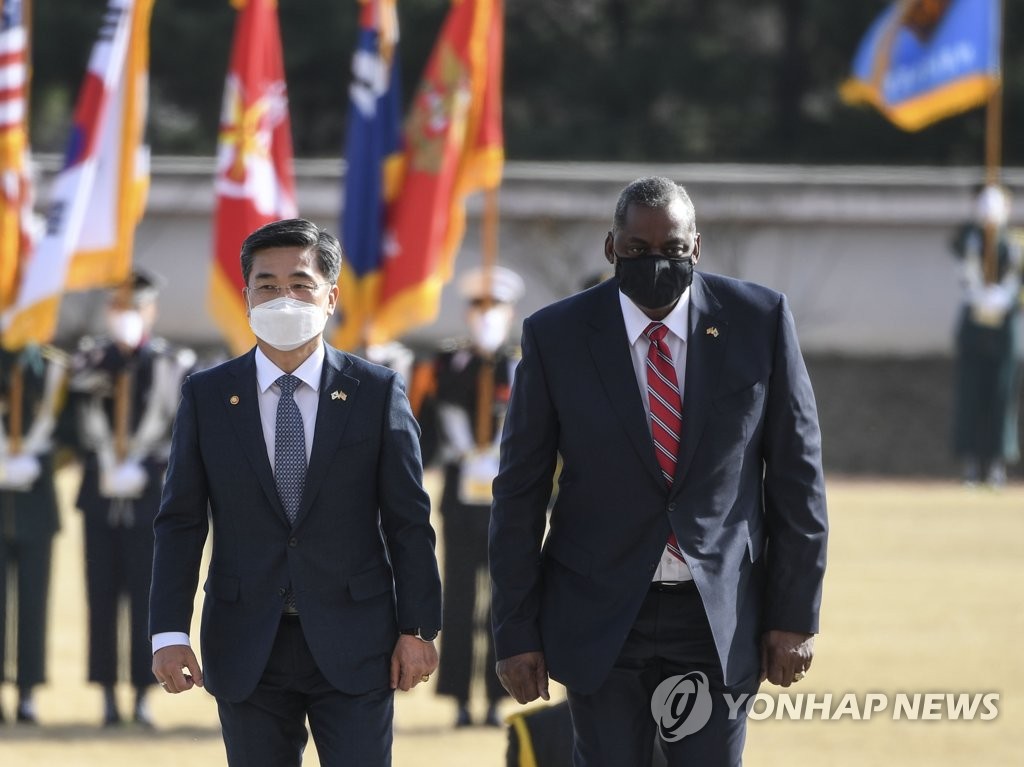- California Assembly OKs highest minimum wage in nation
- S. Korea unveils first graphic cigarette warnings
- US joins with South Korea, Japan in bid to deter North Korea
- LPGA golfer Chun In-gee finally back in action
- S. Korea won’t be top seed in final World Cup qualification round
- US men’s soccer misses 2nd straight Olympics
- US back on track in qualifying with 4-0 win over Guatemala
- High-intensity workout injuries spawn cottage industry
- CDC expands range of Zika mosquitoes into parts of Northeast
- Who knew? ‘The Walking Dead’ is helping families connect
Defense chiefs of S. Korea, U.S. to hold annual talks on OPCON transfer, N. Korea

This file photo, taken on March 17, 2021, shows Defense Minister Suh Wook (L) and his U.S. counterpart, Lloyd Austin, reviewing honor guards before their talks at the defense ministry in Seoul. (Pool photo) (Yonhap)
South Korea and the United States are set to hold their annual defense ministerial talks in Seoul on Thursday to discuss the envisioned wartime operational control (OPCON) transfer, North Korean threats and bilateral alliance issues, officials here said.
Defense Minister Suh Wook and his U.S. counterpart, Lloyd Austin, will lead the 53rd Security Consultative Meeting (SCM), as the allies are stepping up cooperation for regional stability amid North Korea’s evolving nuclear and missile threats and China’s growing assertiveness.
On the conditions-based OPCON transition, Suh and Austin are expected to discuss the timing of the full operational capability (FOC) assessment — the second part of a three-phase program to verify if South Korea is ready to lead the allies’ combined forces during wartime.
Seoul officials have struck a positive note on the potential outcome of the two countries’ discussions on the OPCON handover, raising expectations that they might agree to stage the FOC assessment next year after a pandemic-driven delay.
To cope with evolving North Korean security challenges, the two sides are expected to announce a “new strategic planning guidance” to start the process of developing a new war plan, Defense One, an online news outlet, has reported, citing unnamed U.S. officials.
What Washington terms as the “pacing” challenge from China is also expected to surface at the SCM, John Kirby, the Pentagon press secretary, has said, as the U.S. has been striving to rally its allies for a broader campaign to counter China’s assertiveness.
It remains uncertain whether the SCM joint statement would touch on China-related sensitive issues, given that the SCM has focused mostly on North Korean military threats since its launch in 1968.
Questions also remain over whether the SCM statement would include the U.S.’ commitment to maintaining the current level of 28,500 American troops in South Korea. Last year’s version did not mention it amid tensions over the prolonged cost-sharing negotiations for the upkeep of the U.S. Forces Korea.
The SCM is also expected to touch on the planned return of parts of the U.S. military garrison in Yongsan, central Seoul, to Korean control to back a mega project to build a national park there, as well as cooperation in strategically crucial security realms of cyberspace and outer space.
The SCM originated in 1968 as the “Annual ROK-U.S. Defense Official Meeting” designed to discuss security matters amid high tensions caused by the North’s seizure of USS Pueblo, a Navy intelligence vessel. ROK stands for South Korea’s official name, Republic of Korea.
In 1971, the meeting was elevated to the allies’ annual security talks and renamed the SCM. The SCM has made a series of key decisions for the alliance, including the 1978 creation of both the South Korea-U.S. Combined Forces Command and the MCM.











